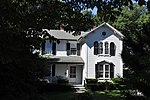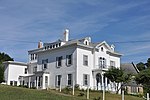Waterford, Rhode Island

Waterford is a village located on and around St. Paul Street in North Smithfield, Rhode Island and Blackstone, Massachusetts. The Blackstone River and Branch River converge just south of the village. Waterford was developed in 1824 by Welcome Farnum, a Yankee entrepreneur, who purchased land, built a dam on the Branch River, and constructed the first textile mill called Red Mill. He named the village Waterford because many of the Irish workers in his mill came from Waterford, Ireland. The last mills in the area were constructed mid-nineteenth century. Waterford is home to St. Paul's Church (1851), originally served a largely Irish population, and sits on the Rhode Island/Massachusetts border. Adjacent to the church is the church school and many businesses.
Excerpt from the Wikipedia article Waterford, Rhode Island (License: CC BY-SA 3.0, Authors, Images).Waterford, Rhode Island
Fountain Street,
Geographical coordinates (GPS) Address Nearby Places Show on map
Geographical coordinates (GPS)
| Latitude | Longitude |
|---|---|
| N 42.0125 ° | E -71.538333333333 ° |
Address
Fountain Street 78
02896
Rhode Island, United States
Open on Google Maps









